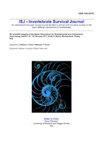Effects of the glutathione administration via dietary on intestinal microbiota of white shrimp, Penaeus vannamei, under cyclic hypoxia conditions
IF 1.2
4区 农林科学
Q4 IMMUNOLOGY
引用次数: 2
Abstract
Environmental stress can impair the survival, growth performance, and intestinal environment of shrimp. The objective of this study was to investigate the effect of glutathione (GSH) on the survival, growth performance, intestinal oxidation, microbiota, and histology of shrimp under hypoxia. Four treatments were used: (1) normoxia, (2) cyclic serious/medium hypoxia (CSMH), (3) CSMH and 75 mg kg−1 GSH, and (4) CSMH and 150 mg kg−1 GSH. White shrimp (Penaeus vannamei) in groups 3 and 4 were fed a commercial diet supplemented with 75 and 150 mg kg−1 GSH for a 28 day period, respectively, and they were cultured under CSMH (0.8 – 3.5 mg L−1 dissolved oxygen) for the last 14 days of the experiment. P. vannamei supplemented with 75 mg kg−1 GSH showed significantly improved survival and growth performance under CSMH compared with the CSMH condition alone. The dose of 75 mg kg−1 GSH completely eliminated overproduction of reactive oxygen species and malondialdehyde to suppress serious histopathological lesions and improve bacterial diversity and the relative abundance of beneficial bacteria, such as Rhodobacteraceae, thereby preventing pathogen (e.g., Vibrio) invasion in the intestine of shrimp under CSMH. However, the dose of 150 mg kg−1 GSH was excessive, as it led to serious impairment of survival and growth. These results indicate that 75 mg kg−1 GSH has the potential to control shrimp mortality and growth inhibition under CSMH in the shrimp farm setting.循环缺氧条件下饲粮中添加谷胱甘肽对凡纳滨对虾肠道微生物群的影响
环境胁迫会影响对虾的生存、生长性能和肠道环境。本研究旨在探讨谷胱甘肽(GSH)对缺氧对虾的生存、生长性能、肠道氧化、微生物群和组织学的影响。采用四种处理:(1)常氧,(2)循环重度/中度缺氧(CSMH), (3) CSMH + 75 mg kg - 1 GSH, (4) CSMH + 150 mg kg - 1 GSH。第3组和第4组凡纳滨对虾分别饲喂在商品饲料中添加75和150 mg kg - 1谷胱甘肽28 d,试验最后14 d在CSMH (0.8 ~ 3.5 mg L - 1溶解氧)条件下养殖。与单独添加75 mg kg - 1 GSH相比,CSMH条件下凡纳滨对虾的生存和生长性能显著提高。75 mg kg−1 GSH完全消除了活性氧和丙二醛的过量产生,抑制了严重的组织病理病变,提高了细菌多样性和有益菌(如红杆菌科)的相对丰度,从而防止了CSMH对虾肠道内病原体(如弧菌)的入侵。然而,150 mg kg - 1 GSH剂量过大,导致生存和生长严重受损。上述结果表明,75 mg kg - 1 GSH有可能控制CSMH条件下对虾的死亡和生长抑制。
本文章由计算机程序翻译,如有差异,请以英文原文为准。
求助全文
约1分钟内获得全文
求助全文
来源期刊

ISJ-Invertebrate Survival Journal
IMMUNOLOGY-ZOOLOGY
CiteScore
2.10
自引率
0.00%
发文量
0
审稿时长
>12 weeks
期刊介绍:
Invertebrate Survival Journal (ISJ) is an international and open access journal devoted to prompt and innovative studies on the basic defense mechanisms in invertebrates, in particular with a view to identifying biotechnologies able to act against derived diseases and related economic damage.
Contributions will be mainly in the form of Letters to the Editor, Visions and Perspectives, Short Communications, Technical Reports, Research Reports, Review, Minireview and Reports of Meetings. Letters to the Editor can be commentaries or perspectives on invertebrate defence mechanisms or replies to the data published in ISJ.
 求助内容:
求助内容: 应助结果提醒方式:
应助结果提醒方式:


